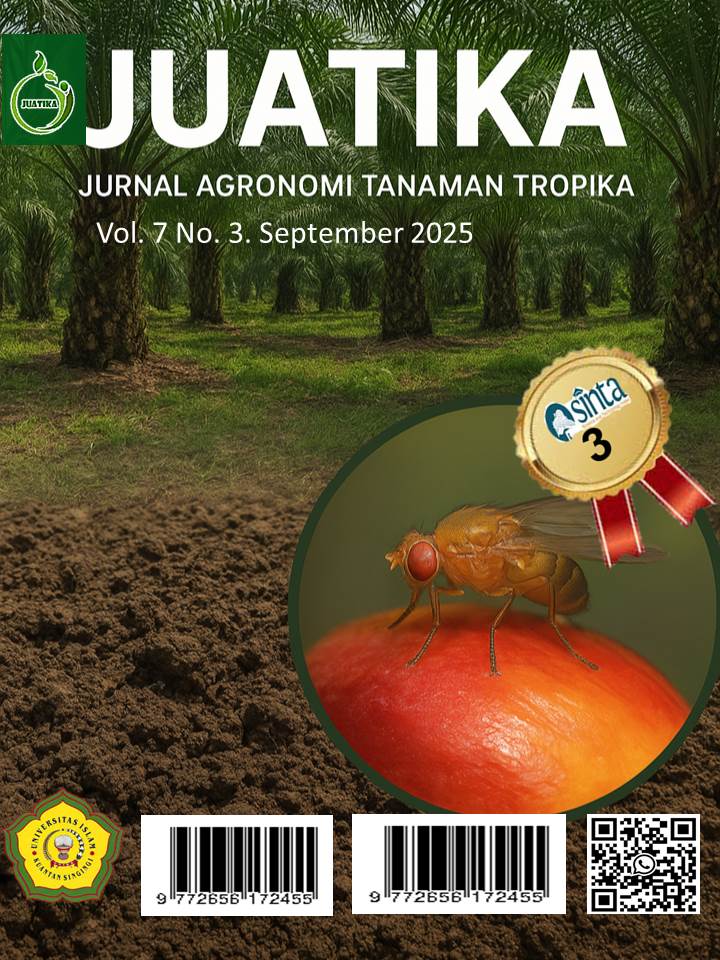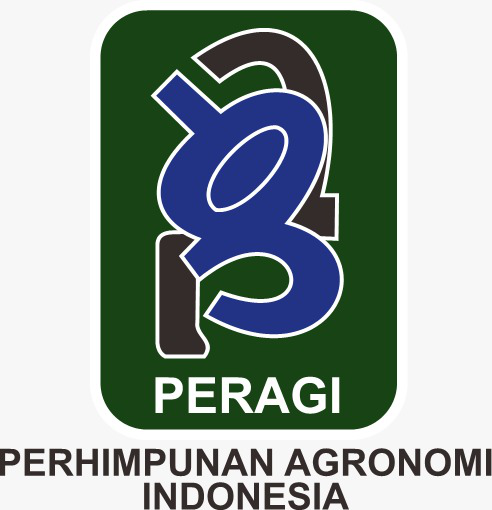Sarcosporidiasis on Rats in Smallholder Oil Palm Plantations in Deli Serdang Regency, North Sumatra
Abstract
Rats are significant pests in oil palm plantations, attacking nearly all growth stages of the plants and causing damage that adversely affects productivity, leading to substantial losses. The protozoan Sarcocystis sp. is a parasite that infects rats and, in sufficient quantities, can cause death in these hosts. This protozoan is naturally present in rats but typically in small amounts. This study aimed to determine the prevalence of sarcosporidiasis (the presence of Sarcocystis sp.) in several rat species inhabiting smallholder oil palm plantations in Deli Serdang Regency, North Sumatra. Rat sampling was conducted from June to August 2025 using baited traps. The captured rats were then identified and categorized by species, sex, and weight. Sarcocystis sp. infection was detected by observing the presence of 'milky white threads' in the muscles, particularly in the rats' legs. The data obtained were analyzed both descriptively and quantitatively. Results showed that two rat species were captured: Rattus argentiventer and Rattus tiomanicus. Only 29.4% of the captured rats tested positive for the protozoan, of which 63.3% were male and 36.7% were female. All rats testing positive for the protozoan belonged exclusively to the R. tiomanicus species
Downloads
References
Anggara, A. W., Solihin, D. D., Manalu, W., & Irzaman. (2015). Ethogram perilaku alami individu tikus sawah (Rattus argentiventer Robinson and Kloss, 1916) dalam laboratorium. Zoo Indonesia, 24(2), 95–108. https://doi.org/10.52508
Devan-Song, A., Luz, S., Mathew, A., Low, M. R., & Bickford, D. P. (2017). Pythons, parasites, and pests: Anthropogenic impacts on Sarcocystis (Sarcocystidae) transmission in a multi-host system. Biotropica, 49(5), 706–715. https://doi.org/10.1111/btp.12458
Dubey, J., Speer, C. A., & Fayer, R. (2015a). Sarcocystosis of animals and man (2nd ed.). CRC Press.
Dubey, J., Speer, C. A., & Fayer, R. (2015b). Sarcocystosis of animals and man (2nd ed.). CRC Press.
Fajri, D. P., Seprido, & Haitami, A. (2021). Kajian jenis tikus dan intensitas serangan pada tanaman menghasilkan (TM) di perkebunan kelapa sawit Estate Sei Kunyit (PT Tri Bakti Sarimas). Journal Green Swarmadwipa, 10(3).
Ginting, S., & Jäkel, T. (2005). Biological control of rodents view project ASEAN sustainable agrifood systems view project. Jurnal Penelitian Pertanian, 24(1). https://www.researchgate.net/publication/262726109
Hafidzi, M. N., & Saayon, M. K. (2001). Status of rat infestation and recent control strategies in oil palm plantations in Peninsular Malaysia. Pertanika Journal of Tropical Agricultural Science, 24(2), 109–114.
Ikhsan, M., Priyambodo, S., Nurmansyah, A., Hendarjanti, H., & Sahari, B. (2020). Species diversity, abundance, and damage caused by rats in oil palm plantation in West and Central Sulawesi, Indonesia. Biodiversitas, 21(12), 5632–5639. https://doi.org/10.13057/biodiv/d211208
Jäkel, T., Burgstaller, H., & Frank, W. (1996). Sarcocystis singaporensis: Studies on host specificity, pathogenicity, and potential use as a biocontrol agent of wild rats. Journal of Parasitology, 82(2), 280–287. https://doi.org/10.2307/3284161
Jäkel, T., Khoprasert, Y., Sorger, I., Kliemt, D., Seehabutr, V., Suasa-ard, K., & Hongnark, S. (1997). Sarcosporidiasis in rodents from Thailand. Journal of Wildlife Diseases, 33(4), 860–867. https://doi.org/10.7589/0090-3558-33.4.860
Kuswardani, R. A., & Maimunah. (2008). Studi ekobiologi tikus pohon (Rattus tiomanicus) pada ekosistem perkebunan kelapa sawit sebagai dasar pengendaliannya.
Ouaarous, M., El Fakhouri, K., Taarji, N., Baouchi, A., Amri, M., Ramdani, C., Sobeh, M., Mesfioui, A., & El Bouhssini, M. (2025). Impact of field insect pests on seed and nutritional quality of some important crops: A comprehensive review. ACS Omega, 10(9), 8779–8792. https://doi.org/10.1021/acsomega.4c08982
Pahan, I. (2008). Panduan lengkap budidaya kelapa sawit: Manajemen agribisnis dari hulu hingga hilir. Penebar Swadaya.
Paperna, I., & Martell, P. (2000). Fine structure of the development of Sarcocystis singaporensis in Python reticulatus from macrogamont to sporulated oocyst stage. Parasite, 7, 193–200.
Pradana, M. G., Priwiratama, H., Prasetyo, A. E., & Susanto, A. (2020). Pengendalian hama terpadu: Tikus di perkebunan kelapa sawit. Pusat Penelitian Kelapa Sawit. www.kliniksawit.com
Prakas, P., Stirkė, V., Šneideris, D., Rakauskaitė, P., Butkauskas, D., & Balčiauskas, L. (2023). Protozoan parasites of Sarcocystis spp. in rodents from commercial orchards. Animals, 13(13). https://doi.org/10.3390/ani13132087
Priyambodo, S. (2009). Pengendalian hama tikus terpadu (4th ed.). Penebar Swadaya.
Rahutomo, S., Wiratmoko, W., Pradiko, F., Hidayat, M., Syarovy, H., Santoso, W., Winarna, W., Sutarta, E. S., Muhayat, R., Nurkhoiry, Z. P. S., Nasution, R., Farrasati, D., Sachnaz, & Oktarina, S. D. (2019, Juni). Kesenjangan produktivitas (yield gap) kelapa sawit Indonesia. PPKS.
Reddy, A. M., & Mehelis, C. N. (2015). Pre-release efficacy assessment of the leaf-mining moth Digitivalva delaireae (Lepidoptera: Glyphipterigidae), a potential biological control agent for Cape-ivy, Delairea odorata (Asteraceae), in western North America. Biological Control, 90, 67–74. https://doi.org/10.1016/j.biocontrol.2015.05.012
Siregar, M. A. N., Manullang, M., Siregar, R. T., & Damanik, S. E. (2019). Dampak perusahaan kelapa sawit PTPN-IV terhadap kesejahteraan sosial masyarakat dalam pembangunan wilayah di Desa Kedai Damar, Kecamatan Pabatu, Kabupaten Serdang Bedagai. Regional Planning, 1(1), 39–53.
Subiantara, A., Hakim, A. R., Diana, R., Wijaya, N. C., Yusuf, M., & Arianti, S. (2022). Analisis kerugian serangan hama tikus di perkebunan kelapa sawit (Studi kasus di PT Sakti Mait Jaya Langit). Prosiding Seminar Nasional Jilid 1 Universitas PGRI Palangkaraya, 63–73.
Sudarmaji, & Herawati, N. A. (2009). Ekologi tikus sawah dan teknologi pengendaliannya. Balai Besar Penelitian Tanaman Padi.
Susanto, A., Prasetyo, A. E., Priwiratama, H., Perdana, T. A., & Sudharto. (2012). Pengendalian terpadu Oryctes rhinoceros di perkebunan kelapa sawit. Pusat Penelitian Kelapa Sawit.
Swastiko, P. (2021). Identifikasi tikus. Dalam Pelatihan virtual entomologi kesehatan dan pengendalian vektor Kementerian Kesehatan.
Tobing, M. C., & Siregar, A. Z. (2009). Penggunaan protozoa Sarcocystis singaporensis (Apicomplexa: Sarcocystidae) untuk pengendalian tikus sawah Rattus argentiventer. Jurnal Hama dan Penyakit Tumbuhan Tropika, 9(1), 39–45.
Widiyanto, A. (2022). Pengendalian OPT tikus dan busuk batang. Dalam Pelatihan Tematik Berbasis Korporasi Mendukung Food Estate Angkatan VIII (Pengendalian OPT dengan Konsep PHT), April.
Copyright (c) 2025 Makhrani Sari Ginting, Henry Budi Hasibuan, Sulaiman Ginting

This work is licensed under a Creative Commons Attribution 4.0 International License.
Authors who publish with Jurnal Agronomi Tanaman Tropika (JUATIKA) agree to the following terms:
Authors retain copyright and grant the Jurnal Agronomi Tanaman Tropika (JUATIKA) right of first publication with the work simultaneously licensed under a Creative Commons Attribution License (CC BY 4.0) that allows others to share (copy and redistribute the material in any medium or format) and adapt (remix, transform, and build upon the material for any purpose, even commercially) with an acknowledgment of the work's authorship and initial publication in Jurnal Agronomi Tanaman Tropika (JUATIKA).
Authors are able to enter into separate, additional contractual arrangements for the non-exclusive distribution of the journal's published version of the work (e.g., post it to an institutional repository or publish it in a book), with an acknowledgment of its initial publication in Jurnal Agronomi Tanaman Tropika (JUATIKA). Authors are permitted and encouraged to post their work online (e.g., in institutional repositories or on their website) prior to and during the submission process, as it can lead to productive exchanges, as well as earlier and greater citation of published work.







 More Information
More Information



